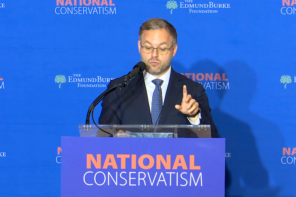When Matthew Heimbach made national news for shoving protester Kashiya Nwanguma at a Trump rally in April, the 25-year-old white nationalist and co-founder of the far-right Traditionalist Workers Party was, not surprisingly, completely unknown to the vast majority of Americans. Nonetheless, Ryan Lenz, the editor of the Southern Poverty Law Center’s Hatewatch blog, told the Washington Post‘s Joe Heim that Heimbach should “be taken as seriously as David Duke.”
The same article that declared Matthew Heimbach a rising star of the far-right also mentioned in passing that his racial views had “led to his excommunication from his Orthodox Christian church.” It was mercifully excluded that Heimbach’s excommunication came only weeks after his formal reception into the Antiochian Orthodox Christian Archdiocese of North America and then only after immense pressure following the online circulation of photographs in which Heimbach appears to be beating a University of Indiana at Bloomington SlutWalk participant with an Orthodox cross.
While Heimbach’s excommunication by the Antiochian bishop means that he is technically unable to receive the sacraments in any canonical Orthodox church, he claims to have found a sympathetic priest in Romania who allows him to communion with full knowledge of the priest’s bishop. It might be easy to dismiss this claim as a half-hearted attempt to save face by a self-aggrandizing racist. Heimbach’s story, however, is not just plausible. It is, in light of so much of the modern Orthodox church’s relationship with the far-right, highly likely.
It is this relationship that has, at least in part, propelled Orthodoxy into the position of “go-to religion” for the white supremacist movement that would prefer to be known as the “alt-right“—not just in the United States, but around the world. When priests in Corinth sprinkle holy water around the new campaign office of the Greek Neo-Nazi party Golden Dawn and the Patriarch of Moscow embraces Vladimir Putin with a gusto that might have embarrassed his tsarist predecessors, there is little doubt as to why Orthodoxy seems appealing to a white nationalist movement. This is especially true since Orthodox opposition to neo-fascism of this kind has been far less frequent and considerably less public.
But contemporary political alliance is only half of the answer, perhaps not even the most important half. The white nationalist movement is invested in a very specific historical narrative. Within this narrative, Western civilization has been felled by attack from without and decay from within. The only hope for its continued survival is a stubborn insistence on resistance, a hunkering down behind the barricades. The two great historical empires that embraced Orthodox Christianity, the Byzantine Empire and the Russian Empire, both provide plenty of fodder for anyone seeking precedence of this narrative.
If one chooses to ignore the inevitable complexity that exists in any nation’s history, it is easy to tell the story of Byzantium and Imperial Russia in a certain way. Here are empires that stubbornly refused to change even as the world around them sped forward, clinging instead to their ancient customs and faith. Here are empires that valiantly resisted advancing Muslim armies. Here are empires that avoided—through force of will and dogged traditionalism—both the Renaissance and Reformation, only to be brought low by forces widely demonized by the far-right. The Muslim Turks conquered the Byzantines, and the Marxist Bolsheviks slaughtered the tsar and abolished his throne. In short, it is easy to tell the story of Orthodox empires in a way that conforms ever so perfectly to the view of history that propels white nationalism. And conversion to Orthodoxy offers the wanna-be Christian soldier a real-life medieval institution, battered by Muslims and Marxists, in which to make his stand.
As an added bonus, he can defend the Catholic faith in a national church. The Orthodox communion is governed through a highly decentralized, synodical system in which 15 self-governing churches—traditionally organized along national/ethnic lines—act with autonomy. While this system of ecclesiastical governance predates by centuries modern concepts of race and nationalism, for a nationalist steeped in the rhetoric of racial separatism, it is impossible not to see a reflection of separatist beliefs.
This is not, by the way, an unusual interpretation of Orthodoxy’s system. As modern racial and nationalist ideology took root in traditionally Orthodox lands throughout the 18th and 19th centuries, plenty of nationalists saw Orthodoxy’s national division as an endorsement of their views. This lead to the condemnation of such ideas by a pan-Orthodox synod at Istanbul in 1872. There the gathered bishops declared, “We renounce, censure and condemn racism, that is racial discrimination, ethnic feuds, hatreds and dissensions within the Church of Christ, as contrary to the teaching of the Gospel and the holy canons of our blessed fathers…”
This synod called the heresy it condemned “phyletism.” It was for this heresy that Matthew Heimbach was formally excommunicated, a charge he and other nationalist Orthodox deny. Nationalism, they argue, is not phyletism. As evidence, they point back to those priests, bishops, and patriarchs who gleefully embrace their political brethren from Moscow to Athens to Belgrade. There might even be a priest in Romania willing to offer them the Eucharist when the P.C. police in Indiana would deny it to them.
But a single priest, who may or may not exist, in Romania is not the problem. Heimbach is just the most visible of Orthodoxy’s new neo-fascist converts. An even cursory perusal of the “alt-right” web reveals a large and growing love affair between the threatening margins of our modern Western political discourse and the ancient Christian faith of the East. The double-headed eagle appears on internet message boards and Orthodox crosses adorn the necks of thugs. What the response of the institutional Church to this courting will be is still yet to be written. Arguably, thus far, it has not been swift, public, or bold enough, because it has not been enough to stop it. If Orthodox churches, in America and abroad, only object to fascists in their midst when it becomes publicly embarrassing, then unflattering internet memes are just the least of our problems.





